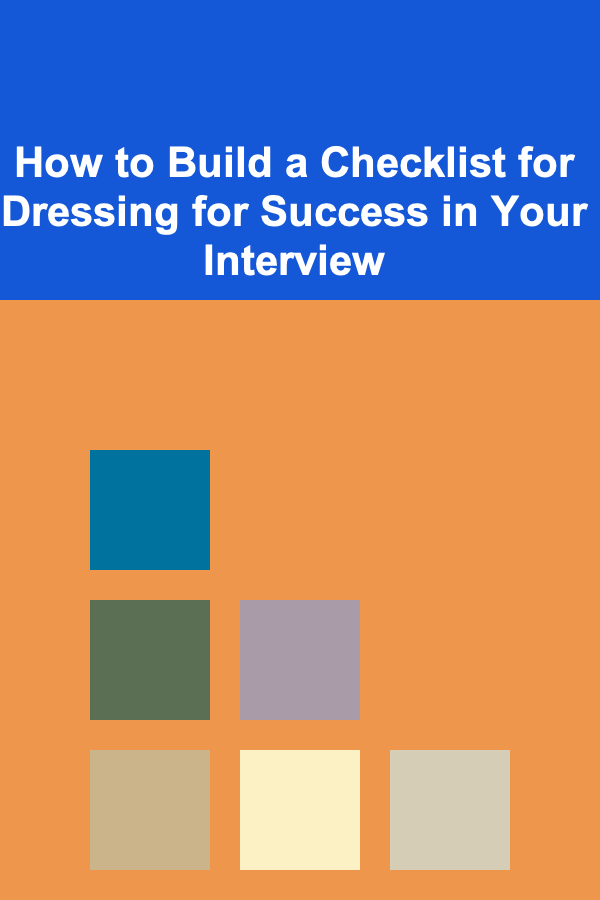
How to Build a Checklist for Dressing for Success in Your Interview
ebook include PDF & Audio bundle (Micro Guide)
$12.99$7.99
Limited Time Offer! Order within the next:

The way you dress for an interview speaks volumes before you even say a word. Your appearance can make or break your chances of success, especially in the highly competitive world of job hunting. Dressing appropriately isn't just about looking good; it's about showing respect for the company, the interviewer, and the opportunity at hand. To help you make the best impression possible, it's important to build a checklist to guide your choices. This article provides an actionable guide on how to build that checklist, covering everything from the basics of professional attire to fine-tuning your personal grooming.
Why Dressing for Success Matters
Before diving into the specifics, it's important to understand why dressing well matters. Employers often make judgments about candidates based on their appearance, especially in the first few moments of meeting. A polished and professional look shows that you take the interview seriously and have invested effort in presenting yourself well.
Beyond looking good, appropriate attire communicates several things:
- Respect: Dressing appropriately signals that you understand the company culture and value the opportunity.
- Confidence: When you look your best, you feel more confident, which can positively impact your performance during the interview.
- Competence: A well-dressed candidate is often perceived as more organized, detail-oriented, and professional.
Now that we've established the importance of dressing for success, let's look at how to create a checklist for your next interview.
Understand the Dress Code of the Company
Every company has its own culture, and the dress code often varies between industries. Understanding the dress code can help you avoid overdressing or underdressing for the occasion. Here's how to figure out what's appropriate:
Research the Company
- Check the company website: Look at images or videos of employees to gauge the general style. Pay attention to photos from company events or "About Us" pages.
- Use LinkedIn: Review employees' profiles and see what they're wearing in their photos. This can give you insight into the day-to-day dress code.
- Consult Glassdoor: Look for reviews of the company that mention the dress code or workplace atmosphere.
Common Dress Codes to Know:
- Business Formal: This is common in industries like finance, law, and banking. It typically involves suits, dress shirts, ties, and polished shoes.
- Business Casual: This is common in many corporate settings and industries like tech or marketing. It includes slacks or skirts, button-down shirts, blouses, or smart blazers.
- Casual: Some companies, particularly in creative fields or tech startups, embrace a more laid-back style. In such cases, neat, clean, and well-fitting casual clothes may be appropriate.
If you're unsure, it's always better to lean toward overdressing than underdressing. You can always adjust your outfit based on the company's environment.
Actionable Tip:
- Contact HR: If you're still uncertain, reach out to the company's human resources or recruiter to ask about the expected dress code.
Choose the Right Outfit
After understanding the company's dress code, it's time to pick your outfit. The key is to balance professionalism with comfort while adhering to the company culture.
Key Components of a Successful Outfit:
- Suit or Blazer: A tailored suit or blazer is the backbone of any interview outfit. A dark color, like navy or charcoal gray, is versatile and professional. If you're dressing business casual, a blazer or smart jacket can elevate your look.
- Shirt/Blouse: A crisp button-up shirt or blouse is often the best choice for both business formal and business casual settings. Choose neutral or solid colors, or subtle patterns (like thin stripes) for a professional appearance. Avoid bright or flashy colors unless you're confident they align with the company culture.
- Pants or Skirt: Tailored pants or a pencil skirt are safe bets for most formal interviews. Make sure the fit is appropriate and that the hem falls correctly. Avoid overly tight or baggy fits.
- Dress: If you prefer dresses, choose one that falls at or slightly below the knee. Keep it simple and avoid overly bright colors or extravagant patterns.
- Shoes: Closed-toe shoes are usually the most appropriate choice for an interview. Oxfords, loafers, or pumps are great options. Make sure your shoes are polished and in good condition.
- Accessories: Keep jewelry minimal and professional. A wristwatch, simple earrings, or a bracelet can add a touch of personality without overpowering your look.
Actionable Tip:
- Lay your outfit out the night before the interview to ensure everything fits properly and is wrinkle-free.
Grooming and Personal Hygiene
Even the most impeccable outfit can be undone by poor grooming or personal hygiene. Here are some key grooming aspects to consider:
Hair
- Haircut: A clean, well-groomed haircut is a must. If you need a trim or touch-up, schedule it in advance of your interview. Make sure your hair is styled in a way that suits the professional setting.
- Hair Length: Keep your hair neat and controlled. If you have longer hair, consider tying it back to avoid distractions. Short hair should be styled so it doesn't look unruly.
- Hair Color: While natural hair colors are generally preferred in formal settings, if you have dyed hair, make sure it's neatly styled and doesn't distract from your overall look.
Skin and Nails
- Skincare: Ensure your skin is clean and fresh for the interview. A light moisturizer and minimal makeup (if applicable) are best. Avoid heavy or distracting makeup.
- Nails: Keep nails clean, trimmed, and polished. A neutral nail color, like nude or clear, is ideal. Avoid overly long nails or bold colors, which might seem unprofessional in formal settings.
Scent
- Perfume/Cologne: Keep fragrance minimal. A light, subtle scent can leave a lasting positive impression, but strong or overpowering scents can be distracting or even unpleasant in close quarters. It's best to skip heavy perfumes or colognes altogether.
- Breath: Fresh breath is a must. Carry mints or gum (and dispose of it before the interview starts). Avoid foods with strong odors, such as garlic or onions, before the interview.
Actionable Tip:
- Keep a grooming kit in your bag, with items like a hairbrush, comb, deodorant, and breath fresheners, so you can do a quick touch-up before the interview.
Pay Attention to the Details
It's the little details that can elevate your outfit and set you apart. Consider these small yet impactful aspects:
- Iron Your Clothes: Wrinkled clothes are a big no-no. Ensure that your outfit is freshly ironed and free of creases.
- Fit and Comfort: Clothes that are too tight or too loose can detract from your confidence. Ensure your clothes fit properly and allow you to move comfortably. If you have to adjust your clothing during the interview, it can come across as unprofessional.
- Bags and Briefcases: A small, neat handbag or briefcase is suitable for most interviews. Avoid oversized bags that can look disorganized.
- Ties and Scarves: If you choose to wear a tie or scarf, make sure it complements your outfit. For ties, simple patterns and solid colors are best.
Actionable Tip:
- Before the interview, perform a "fit check" in front of a full-length mirror to ensure everything looks cohesive, well-fitted, and presentable.
Review Your Checklist Before the Interview
In the final moments before your interview, take a moment to ensure everything is in order. Here's a quick checklist to run through:
- Clothing: Is my outfit clean, ironed, and in good condition? Is it appropriate for the company's dress code?
- Grooming: Are my hair and nails clean and neat? Have I used minimal, non-distracting fragrances?
- Accessories: Have I kept my jewelry and accessories simple and professional?
- Fit: Does my clothing fit well, and am I comfortable?
- Details: Are my shoes polished? Do I have a tidy, organized bag or briefcase?
- Final Touch: Have I brushed my teeth and ensured fresh breath?
Actionable Tip:
- Confidence Check: Stand tall, look in the mirror, and assess your confidence level. If you feel good in your attire, you're likely to perform well in the interview too.
Conclusion
Dressing for success in an interview is a crucial part of making a strong first impression. By building a checklist tailored to the company and role you're applying for, you can ensure that you arrive looking professional, polished, and confident. Understanding the company's dress code, carefully selecting your outfit, and paying attention to grooming and the small details will help set you up for success. Ultimately, when you dress the part, you're signaling to the interviewer that you take the opportunity seriously, making it one less thing to worry about as you focus on showcasing your skills and qualifications.
Reading More From Our Other Websites
- [Biking 101] Essential Bike Repair Tips Every Cyclist Should Know
- [Personal Finance Management 101] How to Reduce Your Monthly Bills and Save More
- [Whitewater Rafting Tip 101] How to Properly Fit and Adjust Your Rafting Life Jacket for Maximum Protection
- [Organization Tip 101] How to Organize Your Books in a Small Apartment
- [Organization Tip 101] How to Develop a Mindful Exercise Routine
- [Home Budget Decorating 101] How to Redecorate Your Bedroom for Less Than $100
- [Home Storage Solution 101] How to Organize Your Digital Files with Cloud Storage Solutions
- [Needle Felting Tip 101] Tools of the Trade: Essential Supplies for Perfect Needle-Felting Portraits
- [Personal Finance Management 101] How to Manage Your Credit Score Effectively
- [Organization Tip 101] Budget-Friendly Wall Stenciling Ideas for Homeowners

How to Find Local Resources for Financial Assistance
Read More
How to Make Your Home Feel Larger with the Right Lighting
Read More
How to Personalize Your Own Corner in a Shared Room
Read More
How to Practice Mindful Consumption
Read More
How to Understand Accessibility in Graphic Design
Read More
How to Conduct Market Research Using ChatGPT
Read MoreOther Products

How to Find Local Resources for Financial Assistance
Read More
How to Make Your Home Feel Larger with the Right Lighting
Read More
How to Personalize Your Own Corner in a Shared Room
Read More
How to Practice Mindful Consumption
Read More
How to Understand Accessibility in Graphic Design
Read More